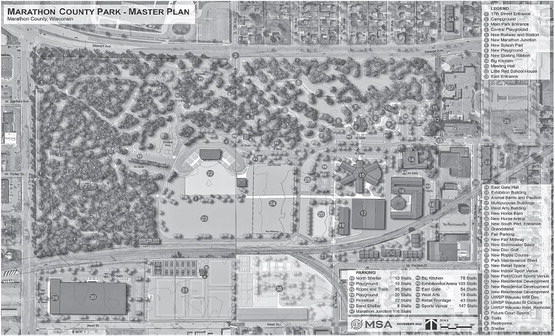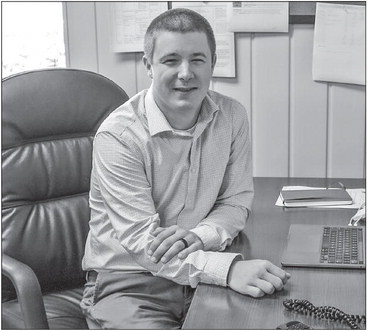County committee OKs West Side plan for Marathon County Park


New indoor sports venue also possible in plan
A Marathon County committee has recommended approval of the county’s West Side Master Plan, which calls for several upgrades to Marathon Park in Wausau, as well as construction of a new indoor sports venue and additional housing units on county-owned land near the park.
Members of the Human Resources, Finance and Property Committee voted last week Tuesday to forward the 15year, multi-stage plan to the full board, which will vote on it next month.
The project plan encompasses three areas on Wausau’s west end – Marathon Park, the University of Wisconsin at Stevens Point-Marathon Campus and a “redevelopment area” just south of the park currently occupied by several county government buildings.
The plan includes 38 potential projects, ranging from improvements and maintenance of park facilities to demolition of county buildings in the area. All together, the project costs amount to an estimated $50 to $70 million, according to county officials.
Jamie Polley, director of Parks, Recreation and Forestry, said the plan was developed under the presumption that the county’s Highway Department will move its facility off of West Street, south of the park, and the Parks Department will relocate off nearby Pardee Street. This will open those areas up for redevelopment in the future.
Jason Valerius, consultant from MSA Professional Services, said community feedback identified the park’s central gravel parking area as particularly “unappealing.” As such, the plan calls for paving and adding curb to that area, he said.
One of the more noticeable changes would be the removal of public roadways and parking on the west end and northeast quadrant of the park, along with reconstruction of the main drive, from Stewart to Garfield Avenue, to include curbs and roundabouts in an attempt to slow down traffic. A gravel path along the side of the park will be paved to provide a new loop around the central area.
Most of the park’s existing structures and amenities, such as the grandstand and Exhibition Hall, will undergo needed maintenance but remain as they are now.
One building, the Marathon Junction, is slated for replacement with a new facility that includes concessions stands, bathrooms, indoor and outdoor seating and possibly an area for a seasonal beer garden. To the north of that new building would be a new splash pad to replace the existing one, and a new east-end playground.
Other potential improvements include the addition of an 18-hole disc golf course and a high ropes challenge course on the wooded west end, and an ice skating “ribbon” that will allow people to skate in a curved loop. The popular railway line would have an expanded route, and the train station would be rebuilt.
“We heard from a lot of people that they enjoy that, from their own childhoods and for their kids,” Valerius said.
One of the top priorities for the project designers was to continue to accommodate the Wisconsin Valley Fair, which has called the park home since it started over 150 years ago. The park’s distinctive white pines and other trees will also be preserved amid the changes, he said.
East Gate Hall, which Valerius called a “bright spot” of multi-use buildings, will undergo some upgrades to make it even more attractive for people who want to rent it out for events like weddings.
The park’s multipurpose buildings will be fixed up, and the indoor skating rinks will still be used for the next five years, but after that, the plan is to move the ice to a newly built facility south of the park. Eventually, a new, slightly smaller multipurpose building will be built for continued use by the fair. The horse barn next door would be moved further away from the railroad tracks.
One of the most expensive proposals in the plan is to build a new indoor sports venue on the corner of 17th Avenue and West Street, where the Highway Department facility is currently located. The venue would include one year-round sheet of ice and another winter ice sheet that could be used for soccer and other turf sports during the rest of the year. An attached retail space is recommended for food and beverage vendors.
To the east of the indoor venue would be an outdoor sports area, which would include basketball courts and 12 pickleball courts on county-owned land currently occupied by a cold-storage building. These courts are now located in the center of the park, but if they are moved to West Street, it would allow for a new and expanded midway for the fair.
“In terms of phasing, that’s going to be one of the later things that happens,” Valerius said. “We’re committed to building new ones before the old ones go away. We want to be clear about that.”
New residential development is also part of the plan, in three different areas.
Townhomes are recommended to replace the current Parks Department headquarters on Pardee Street, just south of the park, and for an unused parking lot on the UW-SP campus on South Eighth Avenue (north of Stewart Avenue). The plan also calls for tearing down Marathon Hall on the UW-SP campus and replacing it with a 30-unit, three-story apartment building.
The only other definite change to the college campus included in the plan is the remodeling of a cafeteria area, which currently houses a private restaurant.
Supervisor Kody Hart questioned a proposal to start charging UW-SP students to park at Marathon Park, and wondered how the county would determine if parked vehicles belonged to students or not.
“Students are really good at dodging fees, so what they’re probably going to end up doing is parking on the streets around the school,” he said.
Valerius said the university would have to look at enforcing any new parking fees, and the city may also need to consider restricting daytime parking in the area around the campus.
Polley noted that the university already pays the county to plow the park’s parking lots for students, even though it doesn’t charge for parking there.
“Parking in general is something the university needs to talk about,” she said.
When supervisor Alyson Leahy asked about revenue projections for the improved facilities, Polley said East Gate Hall and the indoor athletic venue would likely be the biggest money-makers for the county. She said the current seasonal ice rink is already the park department’s secondbiggest revenue-generator after camping.
“There is a potential for a significant amount of revenue with the demand we see now,” she said.
Polley emphasized that the plan as presented is just conceptual at this point, and that individual projects still need to be prioritized based on cost estimates, the possibility of public-private partnerships and the return on investments for users.
“We’re not asking to implement any particular part of the plan at this time, but we need a vision for the park,” she said.
In other business:
n Mary Jo Maly, the county’s risk manager, and Pallin Allen, senior claims representative for Wisconsin Mutual Municipal Insurance Company, told the committee about the process for handling claims filed against the county.
n The committee approved a motion made by Supervisor Hart to add an objective to the county’s strategic plan: To reduce the employee turnover/ resignation rate to 15 percent annually by Dec. 31, 2024.
n County administrator Lance Leonhard told the committee that the county received nine applications, totalling $5.3 million, during its second round of requests for American Rescue Plan Act money. The committee scheduled a special meeting on Dec. 13 at 3 p.m. to review the funding applications.


